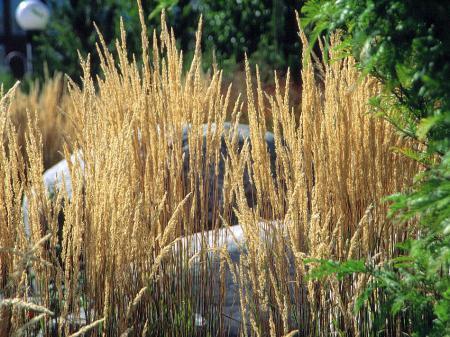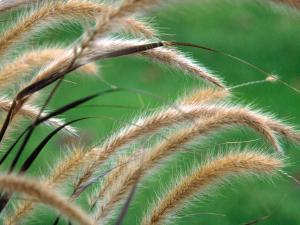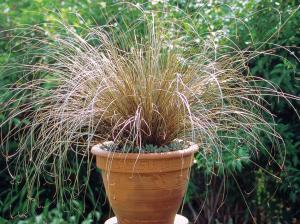Themes in Brown
By Theresa M. Forte
 |
|
| Calamagrostis acutiflora 'Karl Forester' |
Brown can be sombre, interpreted as an ending. But it is also a warm colour, with a remarkable ability to capture and reflect sunlight, it can impart feelings of hope and encouragement. Shades of brown are prevalent in the autumn hues, blending well with a warm range of reds, yellows and oranges. Together they are warm, cozy and comforting.
During the late 1930s and 40s, the war years, times were hard. Nations had been called to duty. Fashion was in a state of limbo, clothing reflected a serious mood, conservative, tailored and predominantly brown. This colour reflected the mentality of the times: people were looking for security, they shared a sense of duty and commitment. Today, colour therapy studies show us that people who prefer the colour brown tend to be committed, trustworthy, hardworking, practical and reliable. Things haven't changed much over the years.
Ornamental grasses offer a fine range of light brown colours and create dramatic opportunities for the play of sunlight in the garden. Light seems to dance on the golden, wheat-like flower heads of magnificent, six-foot tall specimens of Miscanthus sinenesis 'Zebrinus' by mid-August. The yellow horizontal bands that give this grass its common name of Zebra Grass, reflect every available ray of sunlight. With a set of bamboo wind chimes hung nearby, the effect is nearly tropical.
A grouping of the dwarf fountain grass (Pennisetum alopecuroides 'Hameln') is animated by the slightest hint of a breeze. On close inspection, the taupe flowers look like fuzzy caterpillars, with millions of tiny hairs speckled with bronze seeds. They absolutely sparkle when backlit by the low afternoon sunlight. A companion planting of the bronze-plum coloured Aster lateriflorus 'Prince' gives this grouping a wonderful dark backdrop.
|
Also memorable in the late summer garden is the purple-leaved fountain grass (Pennisetum setaceum 'Rubrum'). Long panicles of buff-coloured flower heads gracefully arch above the dark, wine-brown coloured foliage. Inspected closely with a zoom lens, innumerable hairs, all standing on end, resemble the fur of a frightened cat. Like all ornamental grasses, they catch and reflect every speck of sunlight, with delightful results. The burgundy-brown centres of Rudbeckia 'Indian Summer' echo the colouring of grass perfectly, making it a memorable companion.
Rich shades of brown are prevalent in the late fall garden. Deep brown (nearly black) spiky seed heads of coneflowers and rudbeckia punctuate the natural style, low-maintenance gardens that are popular today. Rose-tinted, papery hydrangea blooms give an antique look to the beds. The bark of the trees and shrubs take on a renewed importance. Ancient trees are covered with a furrowed bark that reminds you of the skin of an elephant or rhinoceros. Deep chocolate brown bark contrasts with the golden yellow canopy of the maple trees. The rich mahogany, bronze, red and chestnut browns of oakleaf hydrangea, sweet gum and viburnum add a new dimension to shrub borders. A stroll around Niagara-on-the-Lake in October illustrates my vision of the warm browns of autumn. Narrow roadways canopied by ancient hardwood trees have been transformed into tunnels of amber and mahogany, illuminated from above by golden sunlight. Having completed their spring and summer tasks, the gardens of quaint cottages and stately homes seem content to rest quietly beneath a fresh blanket of papery leaves. Here and there, a waxy bloom of tuberous begonia or fiery red geranium pokes through the leaf covering, as if to remind me that they have not given up just yet. Clothed in a layer of parchment-coloured leaves, the structures of the properties suddenly assume a new importance. A simple white picket fence, standing knee-deep in drifts of leaves, clearly marks the boundary around a cottage. Ornately twisted vines of red and gold soften an imposing wrought iron fence and gateway. A pretty white gazebo seems to be adrift in a sea of russet coloured leaves. A little farther along, simple stone slabs form a gradual rise of steps toward the front gate of a stately home. Their treads are windswept of leaves by a sudden gust of air. In celebration of the fall season, muted orange pumpkins flank bushel baskets overflowing with cheerful chrysanthemums near the top of the stairway. Could any entrance be more inviting? Shuffling through the carpet of dry, papery foliage, it seems time has finally stood still. Was this not the same scent I remember from the walks along the roadway at my grandfather's farm? Memories stir along with the leaves underfoot. The winter garden also benefits from judicious planting of interesting brown accents. The Niagara Parks Botanical Garden features several of my favourite winter pictures. The coppery-brown beech hedge surrounding the Mediterranean garden absolutely glows above a carpet of white snow in winter sunlight, the grid pattern of a lattice gate set against this rich backdrop appears dramatic and timeless. In another section of the park, a stand of mature paperbark maples (Acer griseum) offer coarse, dark brown bark peeling back to reveal the young, cinnamon-coloured bark beneath. Clothed in rusty-brown shaggy bark, seemingly ancient dawn redwood (Metasequoia glyptostroboides) trees stand like giant sentinels in the quiet winter garden. In contrast to the vibrant colours and busy crowds of the summer garden, this park quietly retreats to rest over the winter months. It becomes a welcoming sanctuary garden, suitable for contemplative strolls and long conversations with nature, now dressed down in her basic browns and blanketed in simple white, how comforting. Theresa Forte is a garden columnist, photographer and garden consultant based in Niagara Falls, Ont. Images courtesy Theresa M. Forte |


